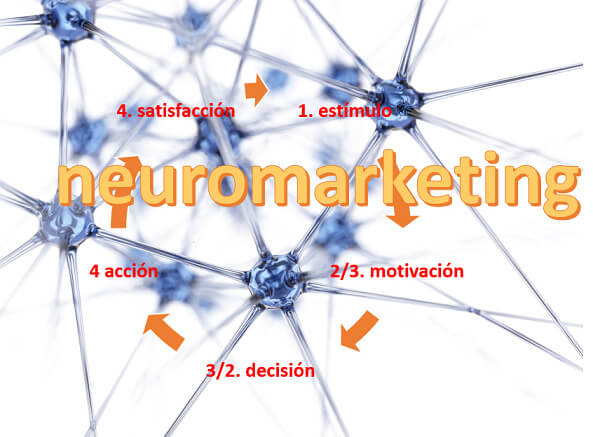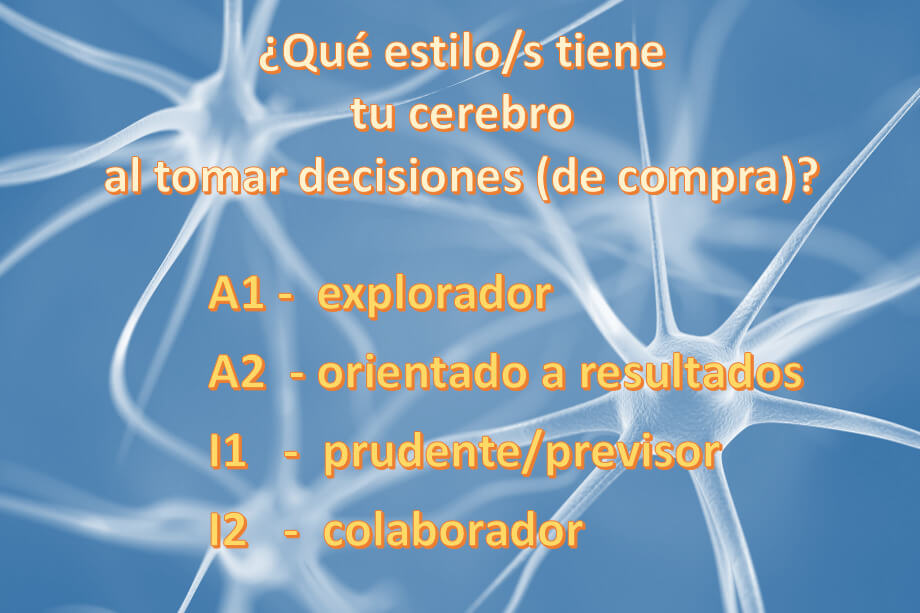We are going to start this article from the end, listing and defining the four Purchase Decision Making Styles that we talked about in the previous article.
The intention is that you can quickly answer the survey that we propose in one of the social networks.
But we have another purpose. We want to explain the different stages of the purchase decision-making process that appeared in the illustration of the previous post on neuromarketing. You will find it later.
Four styles of purchase decision making. Which one(s) is/are, now, yours?
Remember that you may have a tendency to follow more than one of them; and that at different times of your life you have prioritized differently.
A1. Explorer brain
With high frequency you are exploring (externally or internally). Paying, unconciously, attention, to the novelties and what can bring you satisfaction in the present or in the short term. In addition, you have a tendency to imagine and create ideas that generate enthusiasm on your-self.
When something appeals to you, you buy it. Sometimes impulsively. Often your mind creates the novelty and you seek (or create) what you have imagined.
A2. Results focused brain
ou are aware, mainly, of the tangible result that something can bring you. What am I going to achieve with ‘it’ in the medium term?
When something attracts you, you think about the benefit, direct or indirect, that it can be associated with. The purchase is thoughtful, and taking action. But not impulsive.
I1. Cautious and with foresight brain.
You seek tranquility in the face of the uncertainty of the future. You want to be prepared to face the possible difficulties that you sometimes imagine.
You buy something to improve a current situation and/or not have problems in the future. You give it a lot of thought to see which is the option that best serves you now and that is not going to create difficulties for you.
I2. Helping Brain
You seek how you can help or satisfy others. Often your own satisfaction comes from the reflection of other people’s (the one they transmit to you). You catch it with your empathy.
Something catches your attention and, almost immediately, you think of that it would suit or be useful to somebody who you appreciate. Many times you already go shopping thinking about another person/s. You like to give gifts.
Breaking down the purchase decision-making process into stages
We are now going to consider the brain process of making purchase decisions in different stages.
In the drawing / scheme we point out the following stages in the process:
- 1. Stimulus / 2 or 3 Motivation / 3 or 2 Decision / 4. Action / 5. Satisfaction

To explain them, we will consider a couple of examples. The first of them may seem absurd to you. But the purpose is to help differentiate the stages
We will start with a dog that ‘buys’ meat in a supermarket (for dogs, of course).
The dog meat supermarket
Let’s see. Let’s imagine a dog that is exploring its surroundings (its supermarket) looking for cues of reward. Signals that activate its Reward System. The Reward System motivates actions that are rewarded with pleasure, and that have to do with feeding or reproduction. In this way, it favors the survival of the species.
En el entorno que el perro está explorando, hemos dejado dos apetitosos trozos de carne. Uno de ellos normal y otro que huele todavía mejor (para un perro) pero está envenenado.
It is obvious that the pieces of meat are signals that act as sensory stimuli (1) for the dog. These stimuli connect with its brain’s reward system.
The dog’s brain connects the stimulus with its species memory, and in milliseconds it evaluates which piece of meat seems more appetizing. A chemical brain process is triggered, which in humans we call motivation (2/3), the emotion that is prior to action.
Consciously, we have written motivation (2/3) first than decision (3/2). Actually, it is an iterative process, and so underhanded and so fast, that the two stages cannot be distinguished.
In the dog, in the decision stage there is no component of rational deliberation. We will see that this is an important difference with humans.
If the poisoned meat smells better, it will decide that this is the one it wants the most. It will take action (4) and start eating it.
And, what will be the result of the action, its level of satisfaction (5)? How will it influence the next process? Will there be any learning for the next purchase?
If the dose of poison was fatal, it will not have any influence, it is logical. Suppose, but, that it was not. The meat will feel bad, but even so, with high probability, there will be no learning either. The dog needs to repeat the experience several times, so that his memory associates the attractive smell of poisoned meat with a dangerous stimulus.
It’s called conditioned learning.
The human who is going to buy meat to eat
What about people? Is there any difference?
Sure. The main one lies in the prefrontal cortex (PFC). What gives us the ability to think and reason. And, also -very important for what concerns us- to prioritize attention to certain stimuli and to imagine and remember proactively.
Our brain processes what it directly perceives in a similar way as what it imagines or remembers!
And now let’s go buy meat.
It is very likely that we leave the house with the sensory stimulus (1) in mind. It is not necessary that we are in front of the veal fillets or the chicken breasts. We can imagine/think that we want to eat a beef steak, because we remember, for example, the smell of the meat being roasted and/or its taste.
Already, only with imagination and/or memory, we are starting brain chemistry, the emotional process of motivation/decision (2/3).
We arrive at the supermarket and there are no beef steaks like the ones we had imagined! Once the first moments of frustration have been overcome we can begin the decision phase (3/2) or rational evaluation. (Frustration, almost inevitably, follow the motivations/decisions generated in the imagination that cannot be carried out).
We direct our attention towards the different alternatives (stimuli) that activate the motivating emotional limbic systems, at the same time that we think (CPF) and decide. Finally, we take action, we buy. We buy chicken. It didn’t sit well with us last time, but it looks good.
From the stimulus to the action many times a thousandth of a second elapses. Especially if the CPF does not intervene, if there is no reflection phase. This fast process often leads us to attribute our motivations/emotions to stimuli.
And the result, the satisfaction? And the learning for a new purchasing cycle?
Back home, we cook the chicken we bought. We eat it, and it makes us sick. Do we attribute the lack of satisfaction to chicken meat (about which we already had prejudices)? Or was it the sauce with which we accompanied it that was not in good condition?
In any case, it is likely that a similar new decision-making process will not be approached in the same way. This probability will be much greater the more we tend to use the CPF. That is, the more prudent and/or far-sighted our brain is.
The extreme case of purchase decision making in addictions.
Between point 5 (satisfaction) and 1 (stimulus and its perception) we humans can therefore reflect on the result obtained and decide whether or not it is worth starting a similar cycle and doing it the same way as last time, or not.
This is what makes us specifically humans. The possibility of assessing the results, satisfaction, and learning from mistakes.
Once again, the faster the stimulus/motivation-decision/action process, and the less the PFC intervenes in the decision process and the evaluation of the result, the less likely it is to learn.
Take tobacco addiction as an example
In this case, the purchase cycles are chained together with almost total lack of reflection. Impulsive decisions one after another. The stimulus is internal. It is the feeling of need that initiates the motivational process of decision and impulsive action.
Sometimes, a bad experience for the health, not definitive (that does not exceed the lethal dose), helps to create space for the PFC. To reflect on the consequences, and to make a decision that breaks the continuous loop.
Going back to the beginning of the post and the previous one. Now we can better understand what the differences between the 4 purchase decision-making styles are based on: The most frequent type of motivation/emotion in the person and the greater or lesser participation of the CPF in the process.




